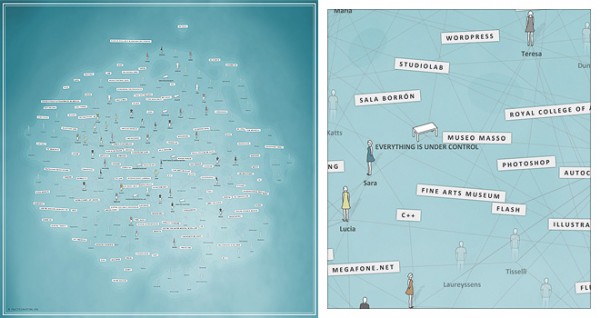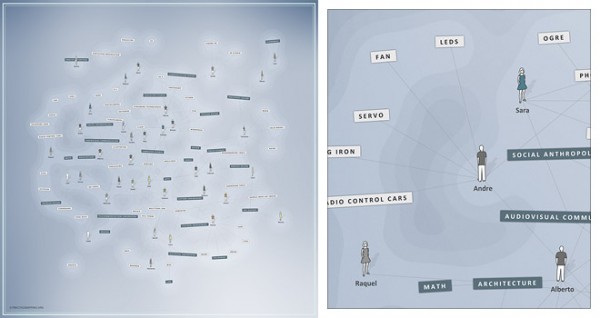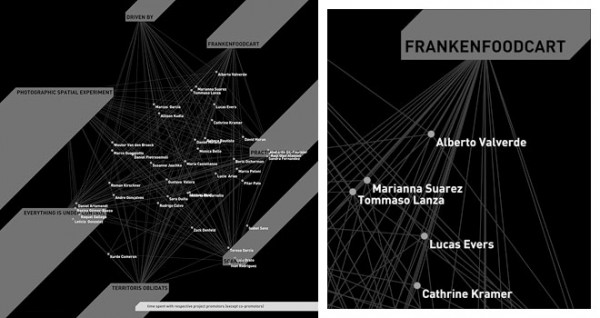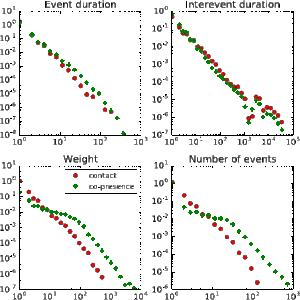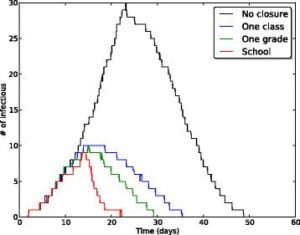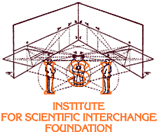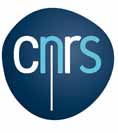DEPLOYMENT: Practice Mapping
Context and objectiveThe Practice Mapping project, a project to be situated at the intersection of art and science, was developed during the Interactivos? LABoral: When Process Becomes Paradigm workshop, from April 8 till April 20, 2010. This workshop took place at the LABoral Centro de Arte y Creación Industrial, which has been steadily acquiring international acclaim for its relentless exploration of the intersections of art, science and technology, since its opening in 2007 in Gijón in Spain. The workshop was organized in the programme of an ambitious exhibition called Process as Paradigm, curated by Susanne Jaschko and Lucas Evers. This exhibition researches the nature of processes and self organising, processual systems on a cultural level and in the arts. Its puts forward the idea that today processes have become one of the major paradigms and creative strategies in contemporary art and design across the disciplines. It aims to reveal the elementary shift from a culture based on the concept of manifestation and the final product, to a culture of process resulting from a networked society.  Left: detail of LABoral entrance. Right: the main workshop space. For the workshop we proposed Practice Mapping, a project that aims to reflect on the creative practice, guided by the premise that it is a compilation and transformation process governed by complex, multifaceted interactions of the author with other people, objects, tools, signs, texts and contexts. The project proposed to collect data on these interactions in a structured manner, and to use scientific analysis techniques to detect patterns and structure in the collected data. The resulting annotated network data should then serve as source data for the computationally generated visualizations, both dynamic and static, which are to form a visual narrative, part cartographic, part tomographic, making visible certain aspects of the interaction dynamics of the investigated creative practice. Data collectionThe data collection efforts were focussed on two main methods. The first involved the deployment of the SocioPatterns platform. All participants, mentors, organizers and support crew members, as well as all spaces, physical tools, and other relevant objects, were outfitted (where possible) with a SocioPatterns badge, while most relevant areas were covered by the reader infrastructure. This enabled us to collect extensive data on the physical face-to-face proximity among the concerned people, as well as the proximity of participants with respect to relevant objects and spaces, resulting in a comprehensive and temporally fine-grained record of the physically grounded interaction network and its dynamics over the course of the workshop.  Various techniques used to outfit objects and areas with SocioPatterns badges. This physically grounded data was complemented with semantic background data collected through interviews and questionnaires covering aspects such as tool usage, training, inspiration and collaborations. The resulting information was interpreted in terms of entities (e.g. persons, tools, or events) and relations (e.g. collaborates-with, likes, or uses) and entered in a computer database.  Left: a picture of the notebook and questionaires, the analogue tools used in the background data collection process. Right: detail of the digital interface used to enter background network data in the database. All obtained data was processed and integrated in a unified network dataset and served to the scripts and applications that generated the visualizations. 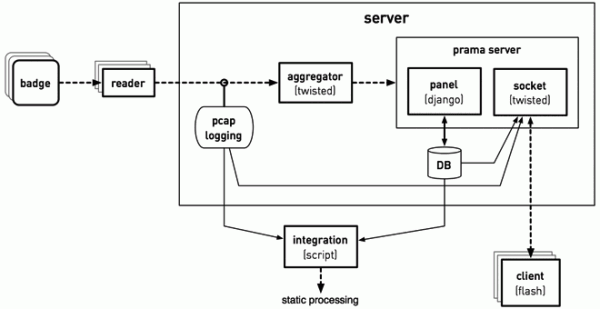 Overview of the various hardware and software components that comprise the system used for collecting, processing, and integrating the data, and serving it back in the form of dynamic socket-based data streams or static files. MapsWe developed a number of scripts and applications that generated a visualization (or map), either static or dynamic, given the collected data. Static Map #1This visualization includes as entities all persons in the semantic network, all organizations, projects and tools. The relations are drawn when there is a relation in the semantic network or when a physical proximity was detected when the map was generated. [Developed by Marco Quaggiotto] Static Map #2The second map aims to provide an overview of the level of activity of each project over time. This activity is measured in terms of the amount of physical proximity detection events per time unit in the proximity of the workspace table/area assigned to the respective projects. Static Map #3This visualization maps out the tool usage of all participants. [Developed by Marco Quaggiotto] Static Map #4A forth map aims to offer an overview of the level of interaction of each participant with the other projects. This quantity is measured in terms of how much time each participant spent near other project tables or the participants of the respective projects. The representations of the persons are plotted such that they are closer to those projects with which they had more interaction. Dynamic Map #1The first dynamic map shows all participants and project tables. Edges are drawn between nodes when they are physically near each other (as detected by the SocioPatterns platform). The nodes are laid out by a force-directed algorithm that aims to position nodes near each other on the map when they are near each other in the physical space. [Developed by Marco Quaggiotto] Dynamic Map #2A second dynamic map shows a (time-lapsed) replay of the growth of the semantic network as we entered data in the system over the course of the workshop. Dynamic Map #3This third dynamic map was developed by Abelardo Gil-Fournier. On the technical side he explored the application of the isometric game engine he developed for the Processing platform. On the visual side he investigated the use of the visual language of computer games, in particular isometric strategy and platform games. He also experimented with the use of horizontal layers (or levels), to provide an integrated representation of the multi-facetted annotated network data. PresentationAt the end of the workshop we were given the opportunity to present our project in the Interactivos? workshop projects area in the Process as Paradigm exhibition. We presented a wall-mounted composition of the various maps we developed, the static ones in the form of prints, the dynamic ones shown in a loop on a flatscreen. 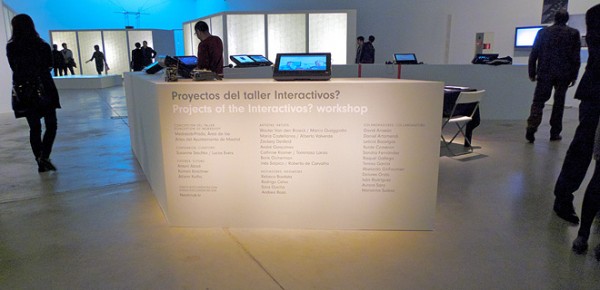 The space in the exhibition where the workshop projects were presented. 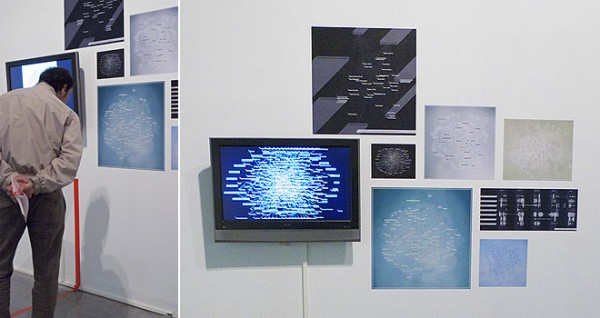 The composition of printed static maps and the dynamic maps, which shown in a loop on a flatscreen. Acknowledgements
|
NEWSNew data sets published: co-presence and face-to-face contactsThrough a publication in EPJ Data Science, we have released several new data sets of different types. These datasets can be found on Zenodo. On the one hand, we have released new temporally resolved data on face-to-face interactions collected in
In addition, we release data sets describing the temporally resolved co-location of individuals, where co-location of two individuals at time t means that the same exact set of readers have received signals from both individuals at time t. Data can be found on our website or on Zenodo. Obviously, the co-location data corresponds to a coarser spatial resolution than the face-to-face data, and we have compared the corresponding data in terms of structure and when used in data-driven simulations of disease propagation models in our paper.
SocioPatterns: measuring animal proximity networksAfter so many measurements concerning humans in different contexts (which we will continue measuring), SocioPatterns has partnered with different institutions to measure proximity networks of animals, ranging from free-roaming dogs to sheep and cows. The goals of the studies range from the study of social networks of animals to the development of better models of disease transmission in animal groups.
School closures to mitigate influenza spread: two studies based on SocioPatterns dataIn order to fight and mitigate emerging epidemics, non-pharmaceutical interventions can become necessary. Among these, school closure is typically regarded as a viable mitigation strategy: children indeed are known to play an important role in the propagation of infectious diseases, due to their high rate of contacts at school. School closure is however a costly measure whose applicability remains uncertain and whose implementation should carefully be weighed on the basis of cost-benefit considerations. In two successive studies published in BMC Infectious Diseases, we have used high resolution data on the contact patterns of children that we collected in a primary school,(i) to define and investigate alternative, less costly mitigation measures such as the targeted and reactive closure of single classes whenever symptomatic children are detected, at the scale of a single school and (ii) to evaluate the effectiveness of several such gradual reactive school closure strategies at the scale of entire municipalities. Our results highlight a potential beneficial effect of reactive gradual school closure policies in mitigating influenza spread. Moreover, the suggested strategies are solely based on routinely collected and easily accessible data (such as student absenteeism irrespective) and thus they appear to be applicable in real world situations. References: Mitigation of infectious disease at school: targeted class closure vs school closure
SUPPORTED BY
|
![SocioPatterns [logo]](http://www.sociopatterns.org/wp-content/themes/sp2/images/header_logo.png)
